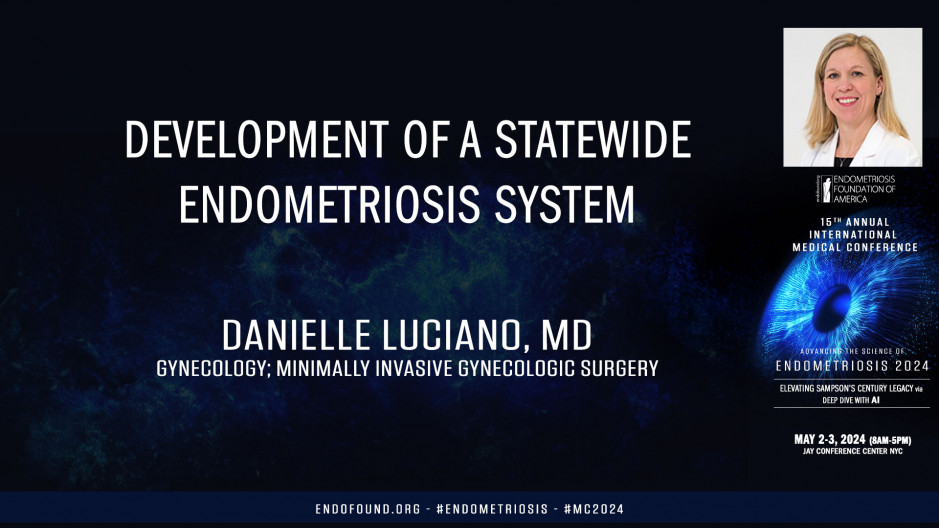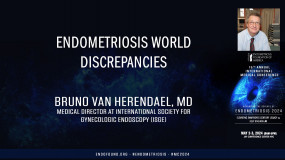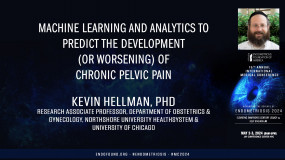International Medical Conference
Endometriosis 2024:
Elevating Sampson’s Century Legacy via
Deep Dive with AI
For the benefit of Endometriosis Foundation of America (EndoFound)
May 2-3, 2024 - JAY CENTER (Paris Room) - NYC
Thank you for this very interesting lecture. May I I to you, professor? This is next. This is previous. This is the point. Okay, got it.
Thank you. And thank you Dr. Sachin and Dr. Martin for inviting me to speak today. I'm the co-director of the state funded data and BIOREPOSITORY program in Connecticut called CT Endo Rise. And today I'm going to tell you about how we got there. So I'm going to tell a story and during my story we're going to talk about background of how we established it, the bumps and triumphs, the way along the way, what we learned and are still learning, and maybe give you some advice on how other states can establish their own program and start sharing all of this knowledge that we have today. Every time I come to these meetings, I learn more and I think if we all work together, we will maybe someday find a cure for this disease. So this all started in the fall of 2020 when representative Jillian Gilcrest from the Connecticut State Legislature reached out to a bunch of researchers and physicians and advocacy groups and formed what was called the Endometriosis Working Group. In this group, like I said, consisted of physicians, researchers, patients advocacy groups, lawmakers, heads of state, medical boards and government liaisons.
And in this working group we brainstormed policy recommendations and consolidated them into one proposal for CT endometriosis data and via repository awareness and education program. So as you can see, there were lots of things that everybody wanted to talk about. And so we looked at all of these things and tried to come up with a program and we presented this program to the legislature and the Department of Public Health. And on May 31st, 2022, Dr. Governor Ned Lamont signed public Act number 2233, an ACT to establish a plan for our endometriosis program. And what was Public Act 2233, it charged the University of Connecticut Health Center where I work. It's a state institution in consultation with a research laboratory to establish an endometriosis data and biorepository program. The goals of this program were early detection of endometriosis in adolescent and adults new therapeutic strategies for treatment and early access to the latest therapeutic options. And the way we were going to do this was going to be to increase research and to increase education and awareness. And Eun Health, along with Jackson Labs, had to present this plan and timeline and budget to the Public health Committee of the Connecticut General Assembly bill later than January 1st, 2023.
So what did we do? The very first thing I did is I sent a cold email to Dr. Stacy Miser and I said, oh my God, I have to put together a bottle of repository in Connecticut. What do I do? For those of you who don't know who she is, and I can't imagine who that would be, she is right over there and she is head of the World Endometriosis Research Foundation. We also reached out to our government liaisons at UConn Health and Jax because I have no idea what to do with the legislature. And then I reached out to my colleagues who had done biobanks before within UConn Health, and I lead on my fellow OSI working group members for advice, support, and ideas. What we didn't do was reinvent the wheel. We didn't try to make a biobank all by ourselves. We looked at all the different other biobanks and followed along with what they did.
We didn't ask for enough help. We asked for a lot, but not enough, and we did not understand the amount of time and support that we needed, but we managed to pull it off. And we presented our comprehensive program to the public health committee in January of 2023. That proposal was accepted by the public health committee and went to the house and the bill was proposed House Bill 66 72 ACT concerning endometriosis. And we submitted the plan and the proposed to your budget. Our plan has seven aims, sample and data collection, standard procedure for collection. This came out of wha, we did not reinvent this. We wanted to target a diverse population around the state. We wanted to enhance research and translational applications. We wanted to establish a knowledge center. A lot of our patients in our endometriosis working groups and our advocates, they said, there's all this stuff out there, but we need it all centralized in one place. And so that's what we wanted to do. We wanted to centralize it. We wanted to make a center of excellence of best practices, and we wanted to evaluate endometriosis impact in Connecticut so that we could show that we were making a difference.
We also wanted to spread this around. So yes, we were going to start at UConn Health and jax, but we also wanted to start collecting from around Connecticut because even though Connecticut's a teeny tiny little state, we do have a very diverse population and we wanted to make sure that got as many patients from all different places as possible. So in year one, we started with UConn Health and we're hoping in year two to move to all of our other neighboring hospitals. For better or for worse, we all know that endometriosis doesn't care what your ethnicity or race is. Seems to like everybody equally.
So we presented House Bill 66 72 to the public health committee and the state legislator, and we sent letters to our Congress members and we had everybody from the Endometriosis working group and all of our patients send lots of letters. And it passed unanimously, not one single vote against us in both houses, both the House and the Senate. And it went into law in July of 2023. So thank you. So then we had a really big task. So now we actually had to do all those things that we said we wanted to do. So the first thing we did was hire some help, some research assistants and program managers. And again, this was under the advice of Dr. Misner who said, go get yourself some help. So we did. And then we started the IRB process right away, like on July 1st. And you'll see later that it took much longer than we expected. We worked on establishing protocols and we used the effect tools to help us. And there is the, for those of you who don't know, they're all infertility and steril in 2014. They're all in there. What we learned, making a website takes a really long time budget work and getting the money from the state to actually get to the hospital and then from the hospital to the research lab, it takes an even longer time. And then the minute that you get approved, everybody under the sun wants your tissue.
So this is it. CT and No Rise. This is our website. We just launched this in March of 2024. It actually took us nine months instead of six months to get it to be launched, but it worked and it is set up, and this is what we are doing. So our IRB, which we started on, maybe it wasn't July 1st, maybe it was July 10th, but we didn't get approved until February 23rd, 2024. And then we got approved from the safety committee on February 29th. And we enrolled our first patient just three weeks ago in April of 2024 because it took just that long to get Red Cap to be able to talk between UConn Health and Jackson Labs. You would think since you were literally, and I will show you a map, five minutes walking distance from each other, but we could talk, but Red Cap can't talk from five minutes away.
But what are we doing? So the first thing we are doing is we're getting together all of our researchers on May 13th, and we're trying to figure out what kind of studies we want to do and what kind of patients we want to have in our study. And we're also having, or in our bio repository, and we're also doing this because endometriosis patients want to be involved, but they need to know about it. And so we need to talk to the doctors so that they can tell their patients to be involved in this filing repository. And then we're having our kickoff meeting in June where we're going to hopefully talk a lot more about how to get this program underway and talk a little bit more about some of the other things that we have discovered, which I'm going to go on with a little bit. And then we're going to try to do a CME course in November on imaging for preoperative planning because it isn't just about having these endometriosis patients and study, but it's about knowing which patients are endometriosis patients. And maybe if we can find 'em earlier with some imaging and with some learning, maybe we can get these patients into our study.
So how do we start a bio repository program? The first thing that you want to do is you want to partner with one of your basic scientists that are interested in endometriosis or women's health. As we know, there has been an increase in funding for women's health over the last year. And so basic scientists are starting to pay a little bit more attention to this and are interested in being involved and reaching out to state legislatures, preferably the ones that are involved in the public health committees or involved in public health bills. Reach out to advocates in your state and nationally. Use the work protocols and SOPs and questionnaires. Please don't reinvent the wheel. You can modify 'em to make them work. Or as I told Dr. Miser, I UConn eyes them because Yukon wants everything to look like Yukon. So I had to kind of make it look pretty, including all of the consents and all that other stuff.
And most importantly, Connecticut is here to help. Representative Bill Crest has already been approached by both Main and New Hampshire to help start and OSI groups and bill's there. And she is always interested in helping out, as am I, and telling you what I've learned and what we've done. So what we've learned and what we're still learning. Everything takes twice as long as you think it will get your help. Early research assistants and program managers, the legislative process is really confusing. There's public acts and then there's bills, and then there's public health committees, which is different from the Department of Public Health, which is different from who's going to actually pass the bill. So there's lots of people that you need to talk to, and that's a language that you need to use and that's what the government liaisons at your hospital or at your lab can help you with.
Look for outside funding early. We are in the process of doing that now. We probably should have done that earlier. Start your IRB process early, even earlier than you think because it really takes a long time look to other researchers and see what they have done. And most importantly, the minute you say you want to do this, you'd be surprised how many people want to help. How many patients want to be involved, how many advocates want to be involved? How many providers and researchers want to be involved? People are willing to help. You just have to get started. And they're afraid to start because they think that this is too big a project and can't be done. And it can, if you say you want to do it and you find the people that will join you. So that's the point. It takes a village.
There's representative RIS who started the whole thing. This is our group right now. There's our research assistant and our program manager and our government liaison, and then me and Dr from js. And here is where I am right here. And if I take this little walk, I go to Elise's place. But somehow Red Cap took six months to get from here to here. I only take five minutes, but I don't know. This is my surgical team in my center of ants. And these are the people who help me collect my tissues. And when I forget to write down what time I took the tissue out of the pelvis and put it into the little tube, they go, Dr. Luciano, I wrote that down for you already. That's amazing. So they are there. The Endometriosis Working Group, the World Endometriosis Research Foundation. I could fill this slide with a number of people that helped, but that's really what's most important is that. And finally, Connecticut, we are not only national basketball champions, but we are also champions for endometriosis. Thank you.










